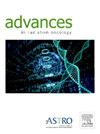质子在大鼠脊髓中的可变相对生物学效应:测量和与模型计算的比较
IF 2.7
Q3 ONCOLOGY
引用次数: 0
摘要
目的研究6次质子作用后大鼠脊髓的相对生物学效应(RBE)与剂量和线性能量传递(LET)的关系。方法和材料采用6种质子(LET: 1.4, 2.7, 3.9和5.5 keV/µm)在6 cm展开的Bragg峰的4个不同位置照射大鼠脊髓。建立终点paresis 2级的剂量-反应曲线,并根据50%效应概率下的剂量计算RBE。包括单次和分次剂量的数据,测量的RBE值与4个机制模型、3个现象学模型和2个患者衍生变量RBE模型的预测值进行了比较。结果随着LET的增大,50%效应概率剂量由51.3 Gy降至43.3 Gy, RBE由1.11上升至1.32。生物等效剂量在2个近端和2个远端脊髓位置之间显著降低,导致外推的最大RBE值在每分数零剂量极限下高达1.87。α/β值在1.5 ~ 4.2 Gy之间。在3.9和5.5 keV/µm时,RBE随剂量的降低而增加,在1.8 Gy /µm时,RBE分别外推至1.40和1.42。在不同的模型中,预测和测量的RBE之间的一致性有所不同。结论1.1的固定RBE可以很好地逼近展开布拉格峰的中心;然而,在距离远端3mm处,RBE明显增加,在临床分数表中可能达到1.4以上的值。因此,使用可变RBE模型的预测可能是合理的;然而,模型和模型参数应该仔细选择,理想情况下作为质子治疗中心的共识。本文章由计算机程序翻译,如有差异,请以英文原文为准。
Variable Relative Biological Effectiveness of Protons in the Rat Spinal Cord: Measurements and Comparison With Model Calculations
Purpose
To determine the relative biological effectiveness (RBE) in the rat spinal cord after 6 fractions of protons as a function of linear energy transfer (LET) and dose.
Methods and Materials
The rat spinal cord was irradiated at 4 different positions of a 6 cm spread-out Bragg peak using 6 fractions of protons (LET: 1.4, 2.7, 3.9, and 5.5 keV/µm). Dose-response curves were established for the endpoint paresis grade 2, and the RBE was calculated based on the dose at 50% effect probability. Including data with single and split doses, the measured RBE values were compared with predictions from 4 mechanistic, 3 phenomenological, and 2 patient-derived variable RBE models.
Results
With increasing LET, the dose at 50% effect probability decreased from 51.3 Gy to 43.3 Gy, resulting in a rise in the RBE from 1.11 to 1.32. The biologically equivalent dose decreased markedly between the 2 proximal and 2 distal spinal cord positions, resulting in extrapolated maximum RBE values of up to 1.87 in the limit of zero dose per fraction. The α/β values ranged between 1.5 Gy and 4.2 Gy. At 3.9 and 5.5 keV/µm, the RBE increased with decreasing dose, and at 1.8 Gy per fraction, the RBE was extrapolated to 1.40 and 1.42, respectively. The agreement between predicted and measured RBE varied between the different models.
Conclusions
A fixed RBE of 1.1 provides a good approximation up to the center of the spread-out Bragg peak; however, at 3 mm from the distal end, the RBE increases markedly and may reach values above 1.4 at clinical fraction schedules. Using predictions from a variable RBE model may, therefore, be reasonable; however, the model and model parameters should be carefully selected, ideally as a consensus among the proton therapy centers.
求助全文
通过发布文献求助,成功后即可免费获取论文全文。
去求助
来源期刊

Advances in Radiation Oncology
Medicine-Radiology, Nuclear Medicine and Imaging
CiteScore
4.60
自引率
4.30%
发文量
208
审稿时长
98 days
期刊介绍:
The purpose of Advances is to provide information for clinicians who use radiation therapy by publishing: Clinical trial reports and reanalyses. Basic science original reports. Manuscripts examining health services research, comparative and cost effectiveness research, and systematic reviews. Case reports documenting unusual problems and solutions. High quality multi and single institutional series, as well as other novel retrospective hypothesis generating series. Timely critical reviews on important topics in radiation oncology, such as side effects. Articles reporting the natural history of disease and patterns of failure, particularly as they relate to treatment volume delineation. Articles on safety and quality in radiation therapy. Essays on clinical experience. Articles on practice transformation in radiation oncology, in particular: Aspects of health policy that may impact the future practice of radiation oncology. How information technology, such as data analytics and systems innovations, will change radiation oncology practice. Articles on imaging as they relate to radiation therapy treatment.
 求助内容:
求助内容: 应助结果提醒方式:
应助结果提醒方式:


